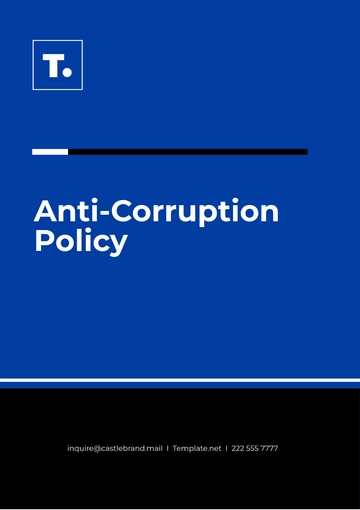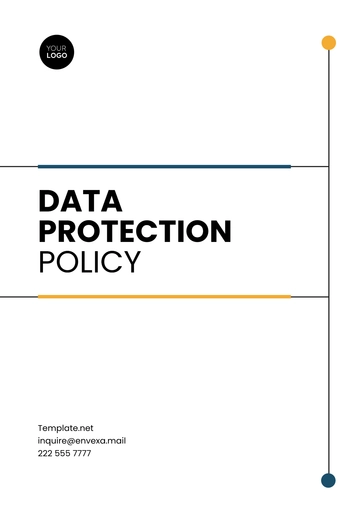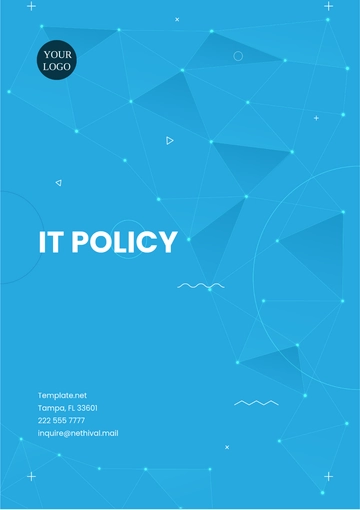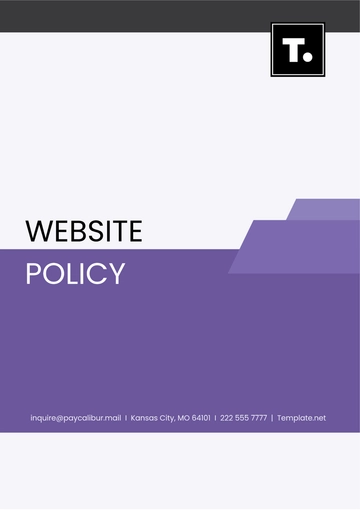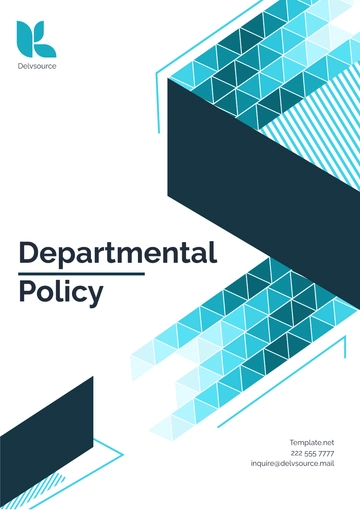Free Operations Project Communication Policy
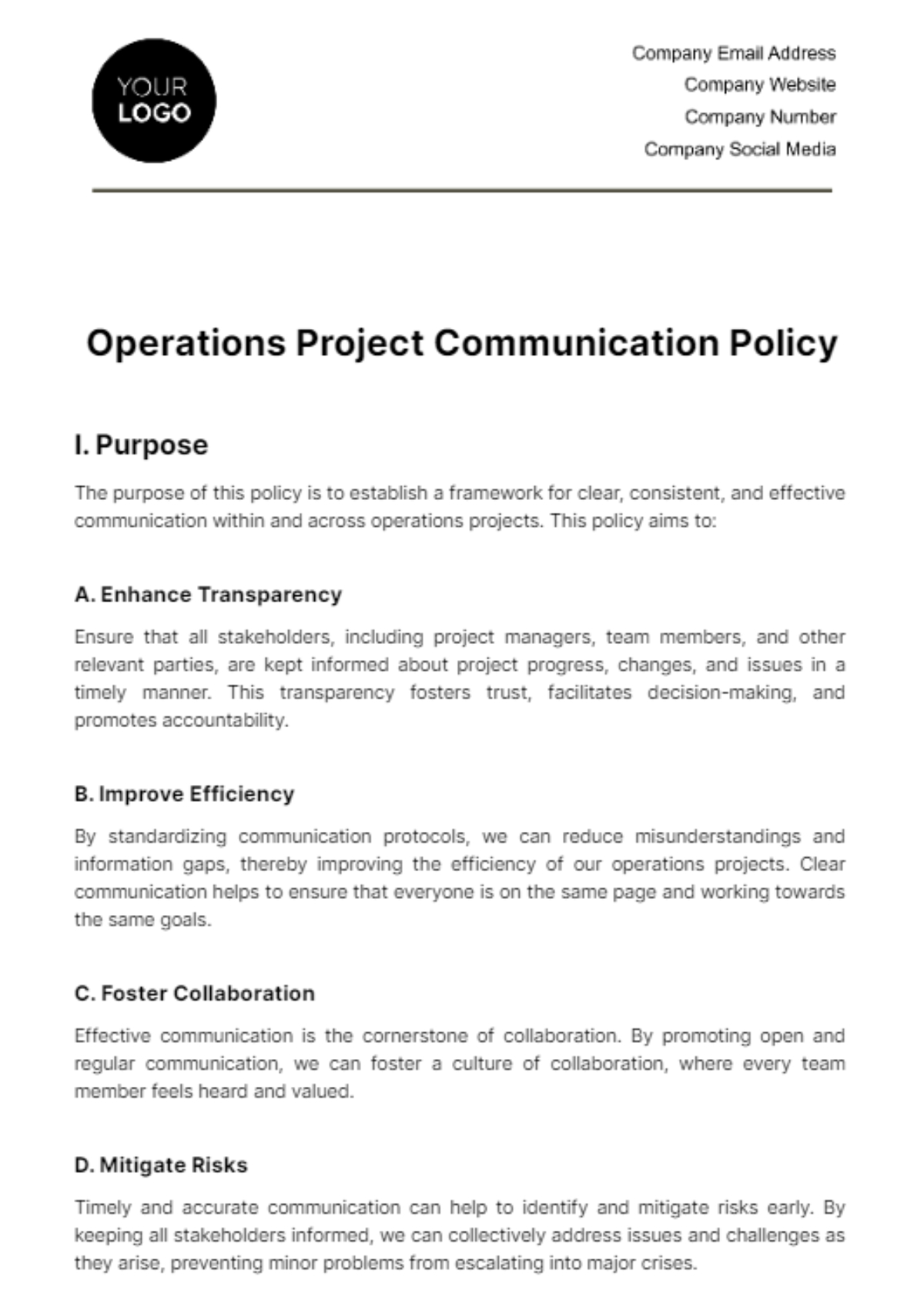
I. Purpose
The purpose of this policy is to establish a framework for clear, consistent, and effective communication within and across operations projects. This policy aims to:
A. Enhance Transparency
Ensure that all stakeholders, including project managers, team members, and other relevant parties, are kept informed about project progress, changes, and issues in a timely manner. This transparency fosters trust, facilitates decision-making, and promotes accountability.
B. Improve Efficiency
By standardizing communication protocols, we can reduce misunderstandings and information gaps, thereby improving the efficiency of our operations projects. Clear communication helps to ensure that everyone is on the same page and working towards the same goals.
C. Foster Collaboration
Effective communication is the cornerstone of collaboration. By promoting open and regular communication, we can foster a culture of collaboration, where every team member feels heard and valued.
D. Mitigate Risks
Timely and accurate communication can help to identify and mitigate risks early. By keeping all stakeholders informed, we can collectively address issues and challenges as they arise, preventing minor problems from escalating into major crises.
II. Target Audience
This policy is intended for all individuals and teams involved in operations projects within our organization. This includes, but is not limited to:
A. Project Managers
Project managers are responsible for overseeing the project, making decisions, and ensuring that all team members are working effectively towards the project goals. They are also responsible for communicating project updates, changes, and issues to all relevant stakeholders.
B. Team Members
Team members are those who are actively working on the project tasks. They are responsible for completing their assigned tasks and communicating their progress, challenges, and any changes in their tasks to the project manager and their fellow team members.
C. Stakeholders
Stakeholders are individuals or groups who have an interest in the outcome of the project. This may include executives, clients, end-users, and other teams within the organization. Stakeholders may not be directly involved in the project work, but they should be kept informed about the project’s progress and any major changes or issues.
D. Support Staff
Support staff such as IT support, HR, and administrative staff, who provide necessary support to the project team, are also included in the target audience of this policy. They should be kept informed about relevant project aspects to provide timely and effective support.
III. Communication Methods
Effective communication is crucial for the success of any project. This policy outlines several methods that can be used to facilitate communication within operations projects:
A. Meetings
Meetings are a direct and interactive way of sharing information. They can be used for:
Project kick-offs: This is the initial meeting where the project plan, objectives, and roles are clarified.
Regular updates: These are periodic meetings to discuss the progress of the project and address any issues or changes.
Decision-making: These meetings are held when a major decision needs to be made involving multiple stakeholders.
Problem-solving: When a problem arises, a meeting can be called to brainstorm solutions and decide on the best course of action.
Closing out projects: At the end of a project, a meeting can be held to review the project’s success and identify lessons learned.
B. Emails
Emails are useful for sending out standard information to all team members. They provide a written record of communication and can be referred back to if needed. Emails can be used for:
Sending meeting agendas: Before a meeting, an agenda will be sent out to let participants know what will be discussed.
Sharing meeting minutes: After a meeting, minutes will be sent to all participants to ensure everyone has a record of what was discussed and decided.
Providing project updates: Regular project updates will be sent to keep all team members informed of the project’s progress.
C. Reports
Reports provide a detailed account of the project’s progress. They can be used to:
Keep stakeholders informed: Regular reports will be sent to stakeholders to keep them updated on the project’s progress and any issues or changes.
Document the project for future reference: At the end of a project, a final report will be prepared to document the project’s achievements and lessons learned.
D. Project Management Tools
Project management tools can be used to plan, execute, and track the progress of the project. They provide a centralized platform where all project information can be stored and accessed by the team. These tools often have features for:
Task assignment: Tasks will be assigned to team members, with due dates and priorities.
Timeline creation: A project timeline will be created to visualize the project schedule and track progress against deadlines.
Progress tracking: The status of tasks will be updated and tracked to provide a real-time view of the project’s progress.
Communication: Most project management tools have built-in communication features such as messaging, comments, and notifications.
E. Informal Communication
Informal communication, such as quick chats or check-ins, can also be effective. They provide a platform for spontaneous discussions, quick problem-solving, and maintaining team morale. While these informal communications are valuable for building team cohesion and fostering a positive work environment, it’s important to remember that any significant decisions or pieces of information should be documented in a more formal communication method. This ensures that important information is not lost and can be referred back to when needed.
IV. Frequency of Communication
The frequency of communication in operations projects is crucial as it ensures that all stakeholders are kept informed and can make timely decisions. The frequency can vary depending on the phase of the project, the nature of the information, and the urgency of the communication. The following table provides a general guideline for the frequency of different types of communication:
Communication Type | Frequency |
|---|---|
Project Kick-off Meeting | Once at the start of the project |
Regular Project Updates | Weekly or Bi-weekly |
Project Status Reports | Monthly |
Decision-making Meetings | As needed |
Email Updates | As needed |
Informal Check-ins | Daily |
The frequency of communication plays a significant role in the success of operations projects. Regular and timely communication helps to ensure that all team members are aligned, informed, and working towards the same goals. It allows issues to be identified and addressed promptly, reducing the risk of delays or misunderstandings. Furthermore, it fosters a culture of transparency and collaboration, where every team member feels valued and heard.
However, while frequent communication is important, it’s also crucial to ensure that communication is effective and not overwhelming. Too much communication can lead to information overload, where important information may be missed or ignored. Therefore, it’s important to strike a balance - communicate often enough to keep everyone informed, but not so often that it becomes a burden. The project manager plays a crucial role in determining the appropriate frequency of communication for each project.
V. Roles and Responsibilities
In the context of project communication, different roles have different responsibilities. It’s important for everyone involved in the project to understand their communication responsibilities. The following table outlines the general communication responsibilities for different roles in operations projects:
Role | Communication Responsibilities |
|---|---|
Project Managers | Oversee overall project communication, ensure all stakeholders are kept informed, make decisions on communication methods and frequency, address communication issues. |
Team Members | Communicate their progress, raise issues or changes in their tasks, participate in meetings and discussions, provide input and feedback. |
Stakeholders | Stay informed about the project’s progress, provide input and feedback, make decisions when required. |
Support Staff | Provide necessary support to the project team, stay informed about relevant project aspects, communicate any issues or changes in their support tasks. |
Understanding and fulfilling communication responsibilities is crucial for the success of operations projects. Effective communication ensures that everyone is aligned, informed, and working towards the same goals. It allows issues to be identified and addressed promptly, reducing the risk of delays or misunderstandings. Furthermore, it fosters a culture of transparency and collaboration, where every team member feels valued and heard.
In essence, the success of operations projects hinges on everyone involved understanding and fulfilling their communication responsibilities. This not only ensures alignment and collaboration but also helps in timely identification and resolution of issues, thereby contributing to the overall success of the project. However, it’s equally important to respect others’ communication responsibilities by avoiding unnecessary communication and being open to their input and feedback.
VI. Confidentiality
Confidentiality is a cornerstone of trust in any project, particularly in operations projects where sensitive information is often shared and generated.
A. Respect for Privacy
Respect for privacy is fundamental. All team members must understand that personal information or sensitive data about others should not be disclosed without proper authorization. This includes not only information about other team members but also stakeholders, clients, and third parties involved in the project.
B. Handling Sensitive Information
Sensitive information such as business secrets, proprietary data, and personal information of stakeholders should be handled with utmost care. This involves:
Access Control: Restricting access to such information to those who need it to perform their duties. This could involve password-protected files, secure databases, or locked filing cabinets for physical documents.
Secure Disposal: When sensitive information is no longer needed, it should be disposed of securely. This could involve shredding physical documents or permanently deleting digital files.
C. Secure Communication Channels
When sharing sensitive information, secure communication channels should be used. This could include encrypted emails, secure file transfer protocols, or private meetings. The choice of communication channel should be appropriate to the sensitivity of the information.
D. Non-Disclosure Agreements
In some cases, non-disclosure agreements (NDAs) may be used to legally bind team members to maintain the confidentiality of certain information. NDAs can provide an extra layer of protection for particularly sensitive information.
E. Reporting Breaches
Any breaches of confidentiality should be reported immediately to the project manager or the relevant authority within the organization. This allows the organization to respond quickly to the breach and take steps to mitigate any potential damage.
VII. Issue Resolution
Issue resolution is a critical aspect of project communication. It involves identifying, addressing, and resolving issues that arise during the course of the project.
A. Identification of Issues
Issues can arise at any stage of the project. All team members should be vigilant and proactive in identifying potential issues. This could involve:
Regular Check-ins: Regular check-ins with team members can help identify issues early before they become major problems.
Feedback Sessions: Regular feedback sessions can provide a platform for team members to voice their concerns and identify potential issues.
Project Reviews: Regular project reviews can help identify issues related to project progress, resource allocation, or stakeholder expectations.
B. Reporting of Issues
Once an issue is identified, it should be reported promptly. The project manager should be informed, and the issue should be documented for future reference. This could involve:
Sending an Email: An email can be sent to the project manager detailing the issue, its impact, and any potential solutions.
Raising the Issue in a Meeting: The issue can be brought up in a project meeting to discuss with the entire team.
Logging the Issue in a Project Management Tool: The issue can be logged in a project management tool, where it can be tracked and managed until resolution.
C. Analysis of Issues
Once an issue is reported, it should be analyzed to understand its cause and impact. This could involve:
Discussions with Relevant Team Members: Discussing the issue with team members who are directly involved or affected can provide valuable insights into the issue.
Reviewing Project Documents: Project documents can be reviewed to understand if the issue was due to a misunderstanding or miscommunication.
Conducting a Root Cause Analysis: A root cause analysis can be conducted to identify the underlying cause of the issue and prevent similar issues in the future.
D. Resolution of Issues
After the issue has been analyzed, a solution should be developed and implemented. This could involve:
Changing Project Plans: If the issue is due to a flaw in the project plan, the plan may need to be revised.
Adjusting Resources: If the issue is due to resource constraints, resources may need to be reallocated.
Providing Additional Training: If the issue is due to a lack of skills or knowledge, additional training may be provided to the team members.
E. Review of Issues
After the issue has been resolved, it should be reviewed to learn from the experience. This could involve:
Post-mortem Analysis: A post-mortem analysis can be conducted to understand what went wrong and how it can be avoided in the future.
Updating Project Documents: Project documents should be updated to reflect the resolution of the issue.
Sharing Lessons Learned: The lessons learned from the issue should be shared with the team to prevent similar issues in the future.
VIII. Policy Review
The policy is a dynamic document that should evolve to meet the changing needs and circumstances of our organization and projects.
A. Regular Review
The policy should be reviewed regularly, at least once a year. This regular review ensures that the policy remains relevant and effective in guiding project communication. It provides an opportunity to assess whether the policy is still aligned with the organization’s goals and the current project management practices, and to make necessary adjustments.
B. Feedback Collection
Feedback should be collected from all stakeholders, including project managers, team members, and other relevant parties. This feedback can provide valuable insights into the effectiveness of the policy and areas for improvement. It allows the organization to understand how the policy is being implemented in practice and whether it is meeting its intended objectives.
C. Policy Updates
Based on the review and feedback, the policy should be updated as needed. This could involve adding new sections to address emerging communication needs, revising existing ones to improve clarity or effectiveness, or removing outdated information that no longer serves a useful purpose. These updates ensure that the policy remains a useful tool for guiding project communication.
- 100% Customizable, free editor
- Access 1 Million+ Templates, photo’s & graphics
- Download or share as a template
- Click and replace photos, graphics, text, backgrounds
- Resize, crop, AI write & more
- Access advanced editor
Establish effective project communication with the Operations Project Communication Policy Template on Template.net! This versatile and editable policy ensures a customizable approach to project communications. Leveraging the AI Editor Tool allows for adjustments, aligning the policy with your project communication needs. Guarantee transparent and efficient project interactions by downloading immediately!
You may also like
- HR Policy
- Restaurant Policy
- Company Policy
- Accounting Policies and Procedures
- Website Policy
- Privacy Policy
- Safety Policy
- School Policy
- IT and Software Policy
- Law Firm Policy
- Construction Policy
- Interior Design Policy
- Travel Agency Policy
- Education Academic Policy
- Security Policy
- Real Estate Policy
- Expense Policy
- Software Policy












